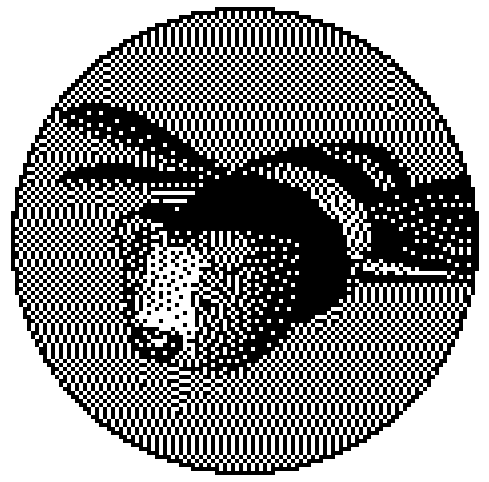View current page
...more recent posts
Anxiety of Influence
1999
Kristin Lucas, mousepad drawings.
Lucas inked a mouseball and let it make gestural drawings while she played games, answered email, etc.
2006
Eyebeam Open Lab - mousepad paintings
Similar gesture paintings made with a USB "double mouse"
(hat tip to jim bassett--demoted from "attack of the clones" to "anxiety of influence" since the Lucas was part meat-space, part virtual and the double mouse is all virtual. it is basically the same idea, though)
Update: another mouse doing "automatic writing," by Joseph DeLappe, from '99 (thx to ed halter)
Update 2: Some critical musings on all this are here.
More digital pog blogging:
An earlier post on the subject of digital pogs addressed only the collectible aspect of these "caps." Yet in the physical world their main purpose, and means of exchange, is a game where the pogs are stacked and knocked over, with the pogs landing face up going to the winner. Some serious thought needs to be given to how digital pogs can acquire the edge of competition, gambling, and classroom disruption that led to their banishment in schools across America in '94-'95.
To put it more bluntly, how do you kick people's asses and get all their pogs with the digital version?

Brown Wolf, 1989, oil on canvas, 54" x 64". After a big corporation purchased a canvas of mine for a high-tech training center it built in Dallas, the director of the center asked if I would accept a commission for a painting of a "brown wolf." (It was an inside reference that I won't explain here.) He stipulated only that it be "a magnificent animal, and I don't want it with its tail between its legs or howling at the moon." The money was good, and while I had done many photorealistic portraits I had never done a "nature painting" per se, so I took it as a personal challenge. As a source I used a black and white image from a Dover book of copyright-free photos, gridded and enlarged it in pencil (old school) and then added the colors (such as they were) from my imagination. The Dover image was of a rather unmagnificent animal obviously in a zoo pen so I had my work cut out for me to make him appear strong and free. Last I saw it was hanging proudly in the lobby of the office building. I have no idea where it is now but due to corporate turnover (and changing tastes) it could very well be in a storeroom or landfill. The piece led to a series of ambiguous, grisaille paintings of copyright-free North American mammals (some of which I've posted and will continue to post here). The photo of the painting is by Harrison Evans.
Looking back at the invoice for this painting reminded me that the director also bought some drawings of mine--one of which was done on the Macintosh with MacPaint. Just to bring this post back to my usual subject matter.
Non-standard digital pogs
whoops, forgot about my self-imposed bandwidth limit for the front page of the blog, so...
I really like Matt Stoller's writing at MyDD:
So anyway, if you need evidence that journalists in DC adopt the biases of their sources and eagerly sop up conventional wisdom, you need go no further than [New York Times temporary columnist Thomas] Edsall. Look at who he doesn't like in this article--pro-choice groups, unions, and minority rights groups. These groups, if you are a Democratic insider, are annoying. They make you do work. They force you to not cut deals with the other side, and they hold Democrats accountable for bad economic choices. They make people like Steny Hoyer and Rahm Emanuel uncomfortable because they demand good policy choices, and by and large aren't (or shouldn't) be willing to trade away core principles to the right for better parking spots.
Edsall of course didn't talk to a janitor who just got a raise in Houston, he didn't talk to a Goodyear worker losing his job, or a displaced New Orleans resident, or a NJ retiree with good pension and benefits because of his union. Edsall talked to his friends, and his friends know, they just know, how important better parking spots are. To these people, knocking labor unions just feels so right, doesn't it? I guess it's a testament to how firmly the intellectual core of journalism has rotted that journalists now work strongly against their own economic interest. Even as Edsall attacks unions as an out of touch "pressure group on the left" that "no longer command broad popular allegiance," his former colleagues are relying on their union to improve journalism and stop the job cuts devastating newsrooms across the country.
[...]I suppose in Edsall's world, corporate media barons are part of the coalition of "dominant," and unions are not. So even though the Republican Party was soundly repudiated at the polls in favor of a strongly populist Democratic Party backed by labor, and a touchstone abortion ban was popularly rejected in one of the reddest states in the country, Democrats have no choice but to reject unions and pro-choice groups, or they will face judgment at the polls.

This digital pog design, by Jeff Sisson, is one of my favorites, so I enlarged it.
Mark Danner on the bad decisionmaking that led to the Iraq quagmire. (Part One) (Part Two) Long but well written and worth a read, the essay will appear in the December 21, 2006 edition of the New York Review of Books. From Part Two:
Nearly four years into the Iraq war...the consequences of [the U.S.'s] early decisions define the bloody landscape. By dismissing and humiliating the soldiers and officers of the Iraqi army our leaders, in effect, did much to recruit the insurgency. By bringing far too few troops to secure Saddam's enormous arms depots they armed it. By bringing too few to keep order they presided over the looting and overwhelming violence and social disintegration that provided the insurgency such fertile soil. By blithely purging tens of thousands of the country's Baathist elite, whatever their deeds, and by establishing a muscle-bound and inept American occupation without an "Iraqi face," they created an increasing resentment among Iraqis that fostered the insurgency and encouraged people to shelter it. And by providing too few troops to secure Iraq's borders they helped supply its forces with an unending number of Sunni Islamic extremists from neighboring states. It was the foreign Islamists' strategy above all to promote their jihadist cause by provoking a sectarian civil war in Iraq; by failing to prevent their attacks and to protect the Shia who became their targets, the U.S. leaders have allowed them to succeed.I still think about the argument I had with someone in 2003, after I had marched in protest of the war: "I just have to believe that the government has expertise and access to information that we don't have and we have to trust that they know more than we do," I was told.
"I Hate The Others" [mp3 removed]
I posted this a few weeks back but I "pumped up the volume" so here it is again.
Update: and again, with better equalization.
